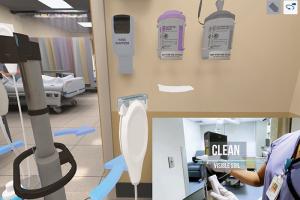Tech talk: Telecommuting robots, continuous monitoring sensors and video game training

The VGo robot helps kids stay connected with school studies.
Robots help kids telecommute to school from the hospital
Young patients at Los Angeles County+USC Medical Center are receiving help from some friendly robots to help them keep up with their school studies. The VGo robots provide remote control-accessed, two-way audio and video, allowing children with extended illness to telecommute to school while staying in a health care facility. The robots are placed within the schools themselves and the patients can use the remote control to move throughout the school.
The program is being funded through a $250,000 grant from Astellas USA Foundation, which partnered with the Starlight Children’s Foundation on the project.
"Access to education is critical for all children, but especially for those who are absent from the classroom due to illness, disability or other health-related challenges," says Amy Stillion, senior director of global impact and philanthropy of Starlight Children’s Foundation. "We are grateful to Astellas USA Foundation for their generous gift and we are proud to partner with them and Los Angeles County USC Medical Center to provide this innovative technology that will support the health and educational needs of children and families in the Los Angeles community."
This year, Astellas plans to fund the placement of 22 VGo robots in 13 Starlight community partners’ location in Massachusetts, Illinois, Oklahoma and California.
Hospital uses video game to prepare for emergencies
A new video game created for Cincinnati Children’s Hospital Medical Center is more than just kids’ stuff. The technology created by students at Miami University’s Smale Interactive Visualization Center will allow hospital staff to train virtually for emergency situations and evacuations.
Eric Hodgson, director of the Miami University at Ohio program told WLTW-TV Cincinnati that there are a “lot of ways to use game techniques, game theory or even game technology to do things you might call serious games.”
The students are developing a series of scenarios in which hospital staff can respond, such as a fire. Staff will take the training wearing goggles, giving them a 360-degree view of the virtual hospital. They will answer questions, learn escape routes and pick up items they need to evacuate.
The video game is part of a larger training program at the children’s hospital, including a training video and mock drill. Researchers will compare which method is most effective.
Medical staff get a head start with continuous monitoring
One manufacturer wants continuous monitoring to be as simple as tucking a magazine-sized sensor beneath a patient’s bed that reports vital medical signals to the health care team.
EarlySense has created technology that can do things like detect vibrations when a patient’s heart contracts and then log that information to track cardiac cycles. The company says its contact-free health sensing and analytics was used on more than 84,000 patients last year, resulting in the prevention of 483 patient falls, 2,070 pressure ulcers and 415 Code Blue events. It estimates that it also was able to save 27,594 hospital days, 4,323 days in intensive care and 332 lives.
One Veterans Affairs spinal cord injury center says it has seen a 60 percent reduction in Code Blue events after using EarlySense for more than one year.




